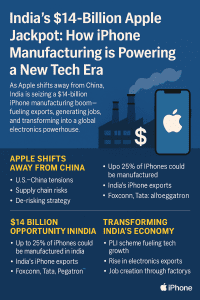California: Apple Inc.’s strategic realignment of its global manufacturing footprint is accelerating—and India is turning out to be the most significant beneficiary of this shift after the United States. With rising geopolitical tensions, U.S. government pressure, and a need for supply chain resilience, Apple is actively reducing its overdependence on China. According to analysts from Jefferies and other global brokerages, this pivot could open up an iPhone production pipeline worth $14 billion for Indian factories.
Here’s a comprehensive analysis of how this $14 billion opportunity is taking shape and what it means for India, Apple, and the global supply chain.
Why Is Apple Diversifying Away from China?
Apple’s long-standing dependency on China for the bulk of its production—particularly iPhones—has come under scrutiny due to several key factors:
-
Geopolitical Risks: U.S.-China trade tensions, rising tariffs, and a push by the U.S. government to shift critical supply chains out of China.
-
COVID-19 Impact: China’s zero-COVID policy caused unprecedented supply chain disruptions in 2022 and 2023, with major Apple plants like Foxconn’s Zhengzhou facility facing lockdowns.
-
Legislative Changes: The U.S. CHIPS and Science Act and other “de-risking” efforts by the Biden administration incentivize companies to move production closer to or within U.S. borders.
-
Investor Pressure: Apple shareholders are also pressing for diversification to ensure production resilience.
These changes mean that Apple has begun to “China+1” its manufacturing strategy—with India now at the center of that policy.
India’s Rise as a Global iPhone Manufacturing Hub
 1. Current iPhone Production in India
1. Current iPhone Production in India
India currently accounts for 7%–10% of Apple’s global iPhone production. While small compared to China’s dominant share (over 90% as of 2023), this marks a massive jump from just 1% in 2020. Apple has rapidly increased capacity through:
-
Foxconn: The largest iPhone assembler in India, based in Tamil Nadu, which recently announced new investments of over $1.5 billion.
-
Pegatron: Operating in Tamil Nadu, expanding its assembly lines for newer models.
-
Wistron (now Tata Group): Tata Electronics acquired Wistron’s India operations, making it the first Indian company to directly manufacture iPhones.
2. Export Boom
India exported iPhones worth over $5 billion in FY 2023–24. This is expected to triple by 2026, making India a key contributor not just for domestic consumption but also for Apple’s global markets.
The $14-Billion Manufacturing Opportunity: Breakdown
Jefferies estimates that it may shift up to 25% of its global iPhone production to India by 2026–27. This means:
-
Annual production worth $14 billion could be undertaken by Indian facilities.
-
The manufacturing includes not just assembly but also sourcing of components, creating a complete local supply chain ecosystem.
This will make India the second-largest iPhone producer globally, after China, within just a few years.
Key Enablers of India’s Growth
1. Government Support through PLI Scheme
India’s Production Linked Incentive (PLI) Scheme for Large Scale Electronics Manufacturing has provided financial incentives to Apple’s contract manufacturers. This includes:
-
Reimbursement of up to 6% of incremental sales over a base year.
-
Encouragement to source components domestically.
-
A push for backward integration, including chip assembly and PCB production.
2. Infrastructure & Policy Reforms
States like Tamil Nadu and Karnataka have become manufacturing hubs, with land grants, tax breaks, and labor reforms targeted at tech manufacturers.
3. Skilled Workforce
India has developed a skilled base of engineers and technicians, aided by training programs from Apple and local governments. Apple has also launched its first retail stores in India to strengthen brand presence and consumer awareness.
Tata Group: A Game Changer
Tata Electronics, by acquiring Wistron’s iPhone assembly unit in Karnataka, has emerged as a homegrown force in high-end electronics. This move:
-
Makes Tata the first Indian conglomerate to assemble iPhones.
-
Allows deeper integration of Indian suppliers into Apple’s global supply chain.
-
Could lead to joint ventures with Apple for future semiconductor or component manufacturing.
Tata is reportedly in talks to build India’s first chip packaging plant, further expanding the scope beyond just assembly.
Impact on Employment and Exports
-
Over 50,000 direct jobs are expected to be created across Apple’s Indian supplier ecosystem.
-
Indirect employment in logistics, component manufacturing, and support services could cross 150,000 jobs.
-
India could generate over $10 billion in tech hardware exports annually by 2027, up from $1.2 billion in 2020.
Challenges India Needs to Overcome
While the opportunity is massive, India still faces challenges:
-
Component Ecosystem: Most high-end parts still need to be imported from China or Vietnam.
-
Logistics Efficiency: Port delays and customs bottlenecks still exist.
-
Electricity and Water Supply: Critical for chip and device manufacturing, needs consistent delivery.
However, these issues are being gradually addressed with dedicated industrial zones and fast-track policies.
Conclusion: India’s Moment to Shine
Apple’s decision to diversify its manufacturing footprint in response to geopolitical and supply chain shocks has opened a landmark $14-billion opportunity for Indian factories. With proactive government policies, the emergence of domestic players like Tata, and the consistent performance of Apple’s contract manufacturers, India is no longer just a market—it is becoming a core part of Apple’s global manufacturing strategy.
This development signals more than just economic growth. It represents a paradigm shift in how global technology giants perceive India—not just as a consumer base, but as a strategic production hub. As India continues to build infrastructure, upskill its workforce, and incentivize innovation, the nation is on track to become one of the most significant pillars of global electronics manufacturing in the coming decade.
You can read more about manufacturing strategy and its growing investments in India from this official source:
Apple’s Supplier List – Apple Official
For more real time updates, visit Channel 6 Network.

